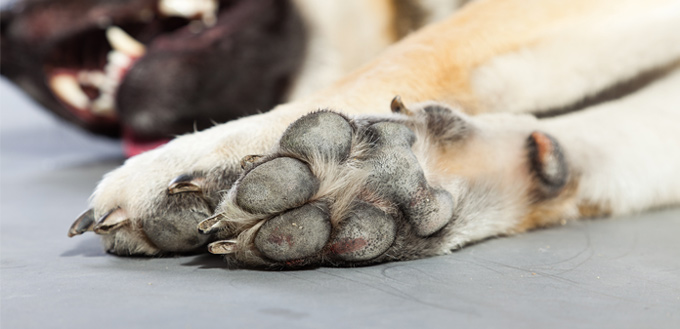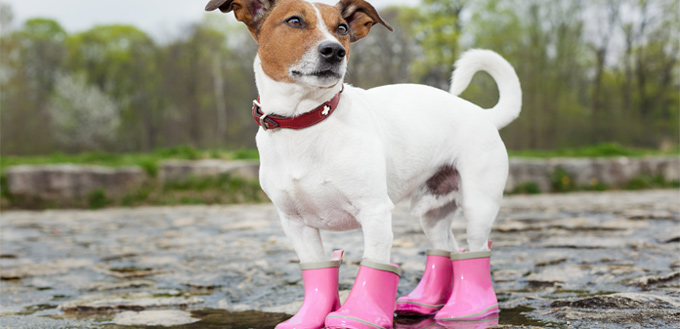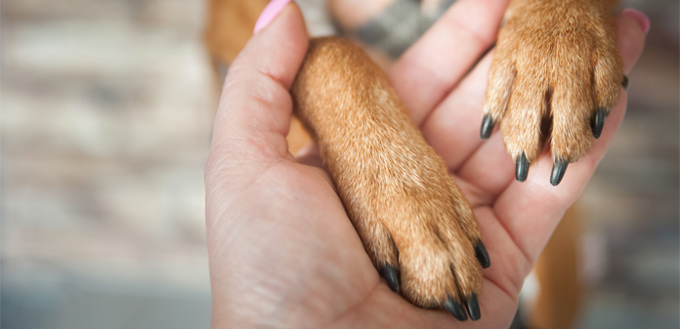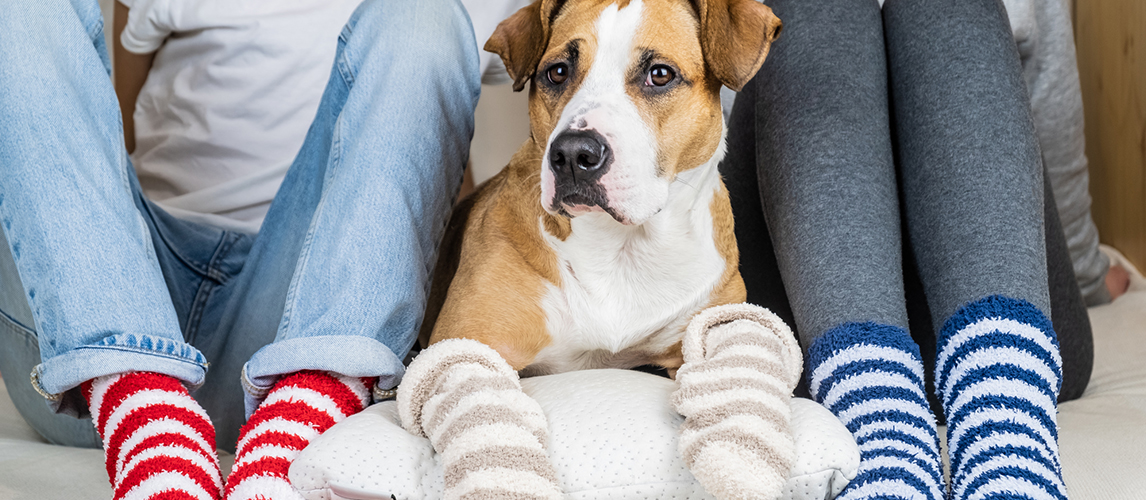All pet parents want to do their best for their furry friend, however, one of the things that you might not have even thought about is protecting their paws from the heat or the cold. Your dog’s paw problems may not present themselves as an immediately obvious issue to consider, however if you don’t treat them in a timely manner, you can find that your poor pooch goes through a lot of pain and discomfort.
While dogs’ paws are fairly sturdy and can put up with a lot, there is only so much that your pet’s feet can cope with, and when paw problems do develop they can last a long time and prove to be difficult to deal with. Once your dog has a problem with their paw it can be hard to treat since your pet needs to walk on his paws all the time, and therefore, the affected area doesn’t have much time to heal.

Prevention is better than cure, especially when it comes to problems with the paws, so to guard against problems like pad burns, frostbite and torn nails from occurring, you need to know how best to protect your pooch’s paws throughout the year.
Here are some top tips to help you to make sure your dog doesn’t have to suffer either in summer or in winter.
1. Wipe Your Pet’s Paws During Winter
The paths and roads during the winter can be covered not only in snow and ice but also in salt and chemicals. All of these have the potential to cause damage to your pet’s paws, so making sure that you always thoroughly wipe your dog’s paws whenever they come indoors from the cold is essential. Getting all of the dirt, ice and salt off their feet means that they won’t suffer from any irritation.
2. Be Careful During Icy Weather
Many dogs like to play outdoors in the winter months, however if you don’t take care to watch over your furry friend as he plays in the ice and snow he could end up getting hurt. Dogs fall and slip just like humans do, and if your pet skids on some ice, he could easily cut his paws on its sharp edges.
3. Don’t Stay Outdoors Too Long In Winter
Even if your pet could happily stay outdoors all day long in the snow, it’s important to limit the amount of time your pooch spends outside when the weather is cold. This is because frostbite is just as much a problem for your furry friend as for you, and can have a harmful effect on your dog’s paws and other body parts. There’s no reason to stop taking your beloved pet outdoors when the snow and ice appears, but you should definitely restrict the amount of time that he runs around in sub-zero temperatures to reduce the risk of frostbite occurring.
4. Consider Foot Wax Or Dog Boots
You would never consider going out on a snowy day with bare feet, and while your pet’s paws are able to cope better with ice and cold than our human feet, that doesn’t mean that you shouldn’t consider protecting them from the worst weather of winter. When you plan to take your pet out in the snow, snow boots specially designed for dogs are one ideal option, especially those which have been designed to have extra traction on their sole to help protect against slips and falls. Dog boots protect your pet’s paws from the freezing surfaces and from the salt that is often spread on them during the winter, however, if your pooch doesn’t like wearing them you could always opt for some paw protection wax which can be applied to your pet’s feet before they go outdoors.

5. Take Care On Hot Surfaces
Most dogs love getting outdoors on a sunny summer’s day, however if the thermometer rises, it’s time to think about your pet’s feet. Roads and path surfaces can get incredibly hot when sitting under the hot sun for hours on end, and this can cause your pet a lot of pain when they head outside for their walk. If you couldn’t walk in your bare feet on the surface because of its excessive heat, it’s too hot for your pet to walk on too. Paw pads are tough, but they aren’t made of asbestos! Whenever possible, walk your pet on grass or dirt instead of paved surfaces on hot days since they can result in pad burns which cause blisters, extreme pain and even tissue loss. Always check your pet’s paws for any sign of a burn after being outside on hot days – some signs to look out for include licking their paw, discolouration of the pad, bleeding and limping.
Related Post: Best Dog Thermometers
6. Examine Their Paws After A Walk
All year round, hiking can be a great activity with your furry friend in tow, however if you’re crossing rough terrain, the chances are that your pet could be in danger of hurting his paws too. Taking care to be mindful of the surfaces your dog is walking over is important, however even when you’re watchful it’s still possible for your pooch to walk over glass or other sharp objects which could lacerate their paws or pads. Thorn and burs are also common problems when going on country walks, and removing any visible objects from their feet is important as soon as possible. If you find that you struggle to get out a deeply embedded object, take your pet to the vet for professional help. If you are going over terrain which might damage their paws, try using a dog backpack carrier to limit the time their feet are on the ground.
Related Post: Dog Backpack Carrier
7. Walk At A Cooler Time Of Day
If it is an especially hot summer, you may need to change the time that you take your pet out for his usual walk. A midday stroll could easily become very uncomfortable for your both, so switching to an earlier hour or an evening time could be the ideal solution. Alternatively, keep your walk brief and supplement those shorter walks with plenty of cool indoor play instead, and always remember to take along plenty of water for your pet to drink to ensure he doesn’t become dehydrated.
Related Post: Best Dog Paw Washer

8. Make Sure Your Pet Doesn’t Mind Having His Paws Touched
Some pets aren’t keen on having anyone touch their paws, and this creates difficulties if your dog ends up with a paw injury or needs their paws groomed. You can help to prevent this from becoming a problem by ensuring that you make a lot of effort to get your pooch used to having his paws handled from as early an age as possible. If you have a puppy, make sure you touch his paws regularly and begin to trim his nails as soon as you can so that he won’t become stressed and anxious when he needs to have his paws handled as he gets older.
9. Keep Those Claws Trimmed
Some dogs need their nails clipped fairly regularly, while others can go for months without needing a trim – it all depends on their lifestyle and breed – however at some point you will definitely need to trim your pet’s claws. If your dog’s nails are long, they will split more easily and be more prone to being torn off. This is very painful and can result in an infection which can take a long time to heal. Walking your dog frequently on pavements can help to keep the nails filed down, however most dog owners need to invest in a pair of claw clippers and treat their pet to a manicure from time to time. It’s also important to remember to check the dewclaw which is higher up on their leg and doesn’t touch the ground leaving it prone to growing too long.
You May Also Like: Dog Nail Clippers & Grinders
10. Take Care With Floor Cleaning Detergents
When you’re cleaning your floors, remember that chemicals that are contained in many of these products are very bad for your pet’s paws. Their skin can absorb those chemicals directly as they walk over the cleaned surface and, even worse, they will be tempted to lick the liquid from their wet paws which will lead to them ingesting the chemicals into their system. Choose your cleaning products wisely to ensure that they are safe for use around animals.
Related Post: Carpet Cleaners for Dog and Pet-Safe Floor Cleaners
11. Check Your Pet’s Paws Regularly
If you incorporate checks on your pet’s paws a regular part of your everyday routine, you’ll find that you are much more likely to spot any issues with his paws at an early stage before the problem gets out of hand. Look for any signs of objects sticking into the skin, any bleeding or rough patches, or any areas of skin which look red and which could point towards an infection, and if you spot any of these issues seek veterinary help. Even if your pet is showing no signs of having any pain or discomfort, take the time to check anyway since they may not always react to potential problems in the way that you’d expect.

12. Healing Minerals Can Help
Sometimes, dietary deficiencies can lead to cracking on the foot pads. If your pet doesn’t have enough zinc or selenium in his diet, his skin may not be strong enough to heal properly, so adding these supplements into his everyday regime may help. Smaller pets should have around 50 micrograms of selenium plus 2.5mg of zinc a day, while larger pets should have around 5mg of zinc and 100 micrograms of selenium.
Follow these tips and you’ll help your pet to avoid the pain and discomfort of sore paws caused by cold, heat or irritants.
Sources:
- Protect Your Dog’s Paws From Winter Weather, Animal Humane Society
- Keeping Dogs’ Paws Healthy, American Kennel Club Canine Health Foundation
- Meghan Lepisto, Protect Your Pets from Winter Hazards, School of Veterinary Medicine
Note: The advice provided in this post is intended for informational purposes and does not constitute medical advice regarding pets. For an accurate diagnosis of your pet's condition, please make an appointment with your vet.






